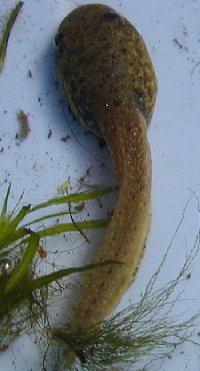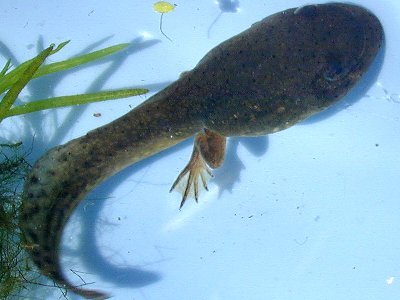|
[AMPHIBIANS]
|
|
|
|
[NOTE THREE CHOICES HERE]
|
|
31a
|
|
Amphibian eggs. Dark, rounded bodies (1 mm or larger) enmeshed in a clear gel
|
[40]
|
|
31b
|
|
Amphibian tadpole. Legs lacking, or only hind legs developed
|
[37]
|
|
|
31c
|
|
Amphibian juvenile or adult. Four legs present; hind legs stronger than fore-legs and adapted for swimming and/or leaping. Tail usually lacking
|
[32]
|
|
|
|
|
~~~~~~~~~~~~~~~~~~~~~~~~~~~~~
|
|
[NOTE THREE CHOICES HERE]
|
|
32a
|
(29) & (31) |
Prominent swellings on side of head behind each eye (parotoid glands) that produces a white, toxic secretion when the animal is handled. Body stocky, front (nose and mouth) rather blunt and short (eyes set forward). Skin warty all over. Color of back varies from mottled tan, black, and white to a more even brown on large individuals. To 18 cm (7 in). Giant neotropical toad, bufo
~ Family Bufonidae
Rhinella marina (L., 1758)
|
[Note B]
|
|
32b
|
|
Without parotoid glands. Front (nose and mouth) blunt and short (eyes set forward); skin generally as described above. Kaua‘i only { European toad
~ Family Bufonidae
|
|
32c
|
|
Without parotoid glands. Front angular, produced forward from eyes. Skin relatively smooth all over or roughened by either circular or linear warts on dorsal surfaces only
|
[33]
|
|
|
|
|
~~~~~~~~~~~~~~~~~~~~~~~~~~~~~
|
|
33a
|
(31) |
Tips of toes expanded (toe pads present)
|
[34]
|
|
33b
|
|
Toes not expanded at tips. True frogs ~ Family Ranidae
|
[35]
|
|
|
|
~~~~~~~~~~~~~~~~~~~~~~~~~~~~~
|
|
34a
|
(33) |
Skin smooth, strikingly colored in black (or dark brown) and green (or white) spots and bars. Small frogs (to 4 cm.) living in wet forests of the Ko`olau (O`ahu). Dart-poison frog
~ Family DENDROBATIDAEDendrobates auratus (Girard) 'Hawaiian'
|
[Note B]
|
|
34b
|
|
Skin with scattered, circular warts; color variable, but typically a brown to olive-green, not strikingly patterned. To 10 cm. Living in wet forests of the Ko‘olau (O`ahu). Cuban tree frog. NAS photo
~ Family HYLIDAEOsteopilus septentrionalis (Dumeril & Bibron)
|
[Note B, Note C]
|
|
|
|
~~~~~~~~~~~~~~~~~~~~~~~~~~~~~
|
|
35a
|
(33) |
Dorso-lateral skin fold (a ridge along upper side of body) extending back from eye nearly to hind leg; otherwise similar to Rana catesbeiana (see below) but of smaller maximum size (under 10 cm). Juveniles may be profusely dark-spotted on back. Green frog
Lithobates [= Rana] clamitans (Latreille)
|
[Note A]
|
|
35b
|
|
Dorso-lateral skin fold absent or extending downward behind eardrum (tympanum)
|
[36]
|
|
|
|
~~~~~~~~~~~~~~~~~~~~~~~~~~~~~
|
|
36a
|
(35) |
Upper surface of body smooth; color mostly olive, green, or brown above, with some large spots on legs and maybe back; green around upper lip. When startled, gives a cat-like alarm cry upon leaping into water. Usually large size (to 20 cm). Freshwater ponds, lakes, and marshes. American Bullfrog
Lithobates [= Rana] catesbeianus (Shaw)
|
|
|
36b
|
|
Upper surfaces of body and legs with rows of linear warts or ridges; color an even gray, brown, or olive with black speckles. Usually small size (to 4.5 cm). Freshwater pools and streams at higher elevations on most Islands. Wrinkled frog
Glandriana rugosa (Temminck & Schlegel)
|
|
|
|
|
~~~~~~~~~~~~~~~~~~~~~~~~~~~~~
|
|
37a
|
(35) & (26) |
Tadpole dark (usually an even black) and usually small (under 2 cm or 1 in)
|
[38] |
|
37b
|
|
Tadpole some shade of olive-green with extensive speckling or mottling of white and/or black; usually larger than 2 cm (3/4 in)
|
[39] |
|
|
|
~~~~~~~~~~~~~~~~~~~~~~~~~~~~~
|
|
38a
|
(37) |
Oral papillae confined to sides of mouth, which is indented. Common and usually present in large numbers in pools, ponds, or quiet waters of streams
~ Family Bufonidae
Rhinella marina (L., 1758)
|
|
|
38b
|
|
Oral papillae on sides and lower lip; mouth indented or not. Found in small numbers, varying in size up to ?45 mm, in isolated pools or other standing water in wet forests on O‘ahu (Ko‘olau)
~ Family DENDROBATIDAEDendrobates auratus ~ Family HYLIDAEOsteopilus septentrionalis
|
[Note A] |
|
|
|
~~~~~~~~~~~~~~~~~~~~~~~~~~~~~
|
|


Figure V9-1. Lithobates catesbeianus tadpoles
|
|
39a
|
(37) |
Tadpole extensively mottled in white with black speckles, to 12 cm in length. American bullfrog (photos above)
Lithobates [= Rana] catesbeianus (Shaw)
|
|
|
39b
|
|
Tadpole mottled gray-green to brown and maybe with white speckles, but with few or no black speckles. Usually under 5 cm total length. Mountain streams and pools. Wrinkled frog
Glandriana rugosa (Temminck & Schlegel)
|
|
|
|
|
~~~~~~~~~~~~~~~~~~~~~~~~~~~~~
|
|
40a
|
(7)
&
(31) |
Spherical ova (eggs) or elongated embryos pigmented on upper surface and arranged within a long, cylindrical (string like), gelatinous sheath. Giant neotropical toad. Common in standing water
~ Family Bufonidae
Rhinella marina (L.)
|
|
|
40b
|
|
Eggs or embryos single, OR in irregular clusters, OR within a floating, gelatinous mass
|
[41] |
|
|
|
~~~~~~~~~~~~~~~~~~~~~~~~~~~~~
|
|
41a
|
(40) |
Eggs or embryos in a floating, gelatinous raft
|
[42] |
|
41b
|
|
Eggs or embryos in an irregular cluster
?Glandriana rugosa (Temminck & Schlegel)
?Osteopilus septentrionalis
|
[Note A] |
|
|
|
~~~~~~~~~~~~~~~~~~~~~~~~~~~~~
|
|
42a
|
(41) |
Ovum with 1 envelope { in a floating cluster to 1.5 m across. American bullfrog
Lithobates [= Rana] catesbeianus (Shaw)
|
|
|
42b
|
|
Ovum with 2 envelopes { in a floating cluster under 30 cm across. Green frog
Lithobates [= Rana] clamitans (Latreille)
|
[Note A] |